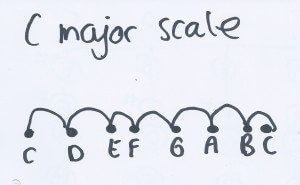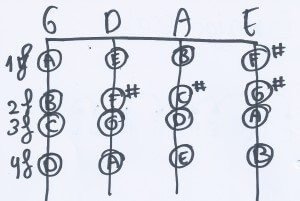The First Notes and Scales You Learn on the Violin (why those sharps?)
Peter asks…
Hi Zlata 🙂
I have a question connected with reading scales.
I’ve learned for example G, D, A – major scales and each of this scales has 1,2,3 sharp keys/notes at the beginning of the piece.
I know how to play each scale but how do I learn to read/understand how to place my fingers by reading the keys.
Could you give me some examples or tutorial?
This is very broad subject and if I would explain everything I know about this, it would be an extended DVD box. Maybe I will create that in the future, but in this short video I will highlight the most important aspects.
When you start playing the violin, you learn the first ‘frame’:
first finger, a high second finger, a third finger next to the second finger and a fourth finger. Watch the video to see how this looks like.
With this fingering you can play a one octave major scale starting on the open G, D and A string.
Here are the fingerings for these three scales…
G major:
0 1 2 3 0 1 2 3 3 2 1 0 3 2 1 0
G D G
D major:
0 1 2 3 0 1 2 3 3 2 1 0 3 2 1 0
D A D
A major:
0 1 2 3 0 1 2 3 3 2 1 0 3 2 1 0
A E A
You might be wondering why you see al those sharps, while you are just learning the first frame.
The reason is that your violin is tuned in fifths, so learning the first frame on every string we have to take notice of this.
Join my FREE beginner violin course
I take you from scratch step by step to your first violin concerto including 40 videos, sheet music and violin tabs.

Hi! I'm Zlata
Classical violinist helping you overcome technical struggles and play with feeling by improving your bow technique.
 The system of Western music is based on octaves. All the sharps and flats are based on the C major scale. The C major scale is the only major scale without sharps and flats.
The system of Western music is based on octaves. All the sharps and flats are based on the C major scale. The C major scale is the only major scale without sharps and flats.
C major simply goes like this: CDEFGABC and there we have a one octave scale.
This scale progresses with jumps between each note. See the first picture for an overview of these jumps: half notes and whole notes: tones and semitones.
If you want to play this exact sequence starting from another note, we will have to add some sharps and flats.
 In the second picture you can see an overview of the first frame on the violin and how these notes are named.
In the second picture you can see an overview of the first frame on the violin and how these notes are named.
In the video I go through all the fingers of the first frame and why they are named the way they are named.
I hope I have made this system a little bit clearer for you. Perhaps watch this video a couple of times and play the three scales together with me to understand everything I say in depth.
Also watch my video ‘Learn to read notes quick and dirty’.
Is this useful to you? Please let me know in the comments below!
Love,
Zlata
PS: Do you have questions or struggles on violin or viola playing? Post a comment below or send an e-mail to info@violinlounge.com and I might dedicate a Violin Lounge TV episode to answering your question!


Hi Zlata;
Now I finally see from your diagram, why we have to play some notes as sharps.
Thank You
Good to hear it’s helpful for you, Dick!
Thank you very much for the lesson first notes and scale which I enjoyed
Glad you enjoyed it, Patrocin!
Ok I understand the sharps and flats. I want to know how to find the right spot on the fingerboard. I understand sometimes the fingers are close together and others are spaced apart. Where How do you find the exact spot to place your fingers to start?
The small steps (tones) are done with your fingers close together and the large steps (semitones) are with a space between the fingers. To find the exact place you need to know how the tone should sound (by playing a recording or playing it on a piano). It takes a lot of time to automate this and find the right spot with your fingers.
You might be interested in the video series I made about playing in tune. Go here to watch the first video: https://violinlounge.com/12-tips-to-play-in-tune-on-the-violin-or-viola-1-to-4/
pls can you up load a pic on how I can play my do rai mi fa so la ti do pls it will or can u give me a link so I play just like you
The video explains exactly that, do re mi is just a different system of naming the notes. Perhaps the Fingerboard Map is something for you: https://violinlounge.com/fingerboardmap/
Zlata what is Concert F on the violin? Thank you
I think you mean a concert in the key of F major (one flat).